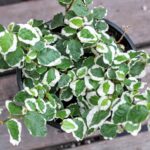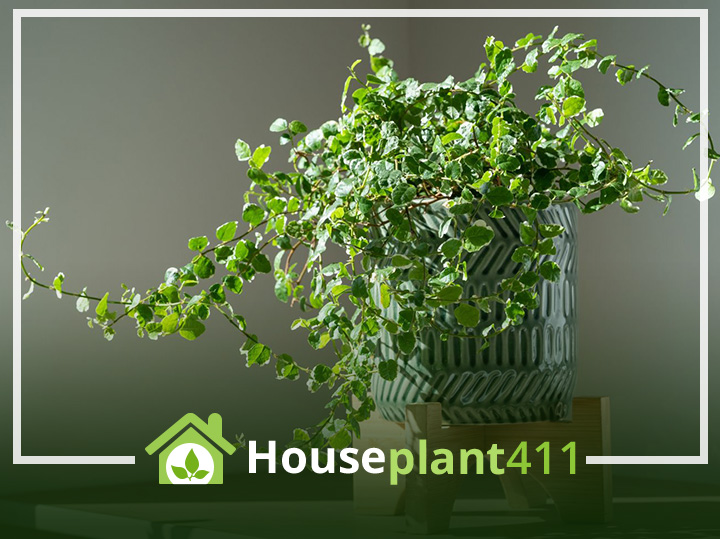Ficus pumila or Creeping fig is a tiny- leafed plant native to Japan, Vietnam and China. Also called a Ficus Repens, it is an excellent table plant, hanging plant, or climbing plant. Since the fast- growing vines of a Creeping Fig easily cling to just about anything, it’s also a great plant if you want to create a topiary. The small (1”-2”), thin, delicate, heart- shaped leaves grow on wiry stems. As a ficus pumila matures, it develops a dense. dark green, mat-like appearance. These plants are considered poisonous and should be kept away from pets and children. Read more about common houseplants that are poisonous in Don’t Feed Me to Your Cat: A Guide to Poisonous Houseplants. The beautiful, variegated type of Creeping Fig needs more bright indirect light than the solid green Creeping Fig plant.

Variegated F. Pumila (Creeping Fig)
Plant Care
Light
A ficus pumila needs indirect light from an east or west-facing window. Plants with variegated leaves require even more light. Creeping fig plants do surprisingly well in strong artificial light.
Water
Keep the soil moist but never soggy. The leaves of a ficus pumila deteriorate if the soil is allowed to repeatedly dry out. Reduce water during the winter.
Fertilizer
Fertilize monthly in the spring, summer, and fall with a basic houseplant food diluted to half the recommended strength. During fall and winter, fertilize every other month.
Temperature
A ficus pumila, also called a ficus repens, does well in temperatures between 55°F-75°F ( 12.8°C-23.9°C)
Humidity
This plant likes plenty of humidity. Place it on a pebble tray filled with water, be sure the plant is sitting on the pebbles and not in the water; put a humidifier close by; or group plants together to cause a mini- greenhouse effect.
Pests
Mealy bugs, scale, whiteflies, and spider mites.
Diseases
No serious disease problems
Soil
Use a highly organic peat-based soil that drains quickly.
Propagation
Use stem cuttings in the early spring.
Poisonous Plant Info
A ficus pumila has a #1 toxicity level.
FAQ
Leaves shrivel and fall off a creeping fig when the soil gets to dry. Keep the soil moist but never soggy and keep the soil a bit drier during the winter.
A ficus pumila (creeping fig) likes humidity, but keeping the leaves wet from misting attracts Mealy Bugs which are what those “white, sticky, cotton- like” things are. Spray your plant with the ” green solution” (instructions on how to make this water and alcohol pest killer are is in the Glossary) to get rid of the Mealy Bugs; be sure to spray all parts of the plant.
Do not rush to repot a creeping fig (ficus pumila). This plant grows best when root bound in a small pot. For the first year or two, when the plant is immature and small, repot it in the spring. Be sure to use a pot only an inch or two larger than the original pot. Once the plant is mature, it does not need repotting; replace the top few inches of soil with new rich organic soil once a year.
The leaves of a ficus repens (creeping fig) become pale and anemic looking when the plant os getting too much sun. Move your plant away from a southern or western exposure to a northern or eastern exposure. Also examine the plant closely to make sure it doesn’t have spider mites.

